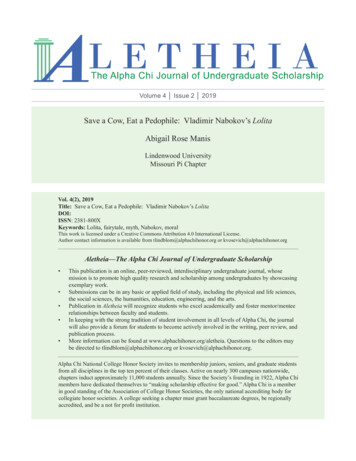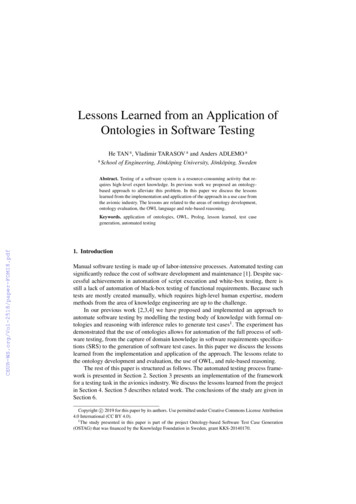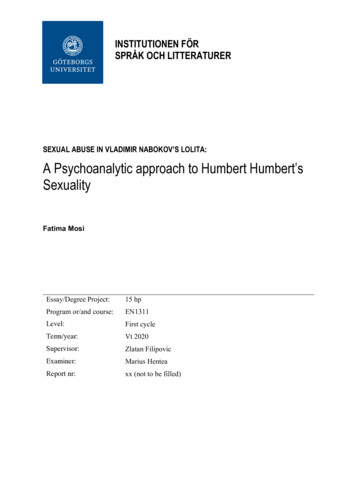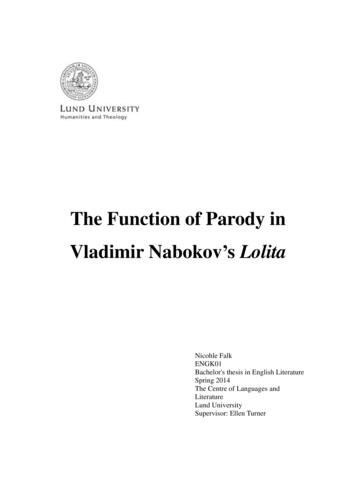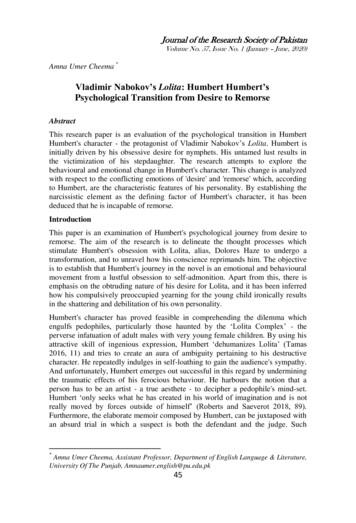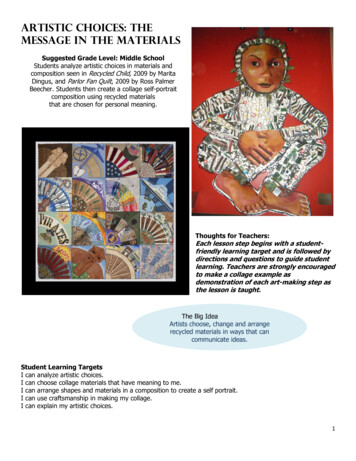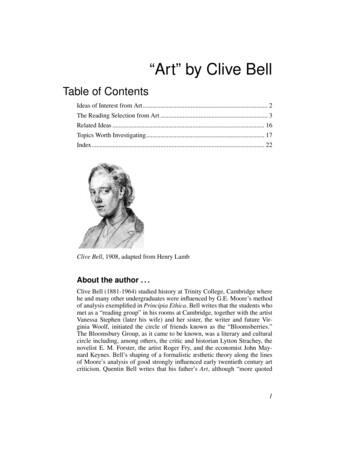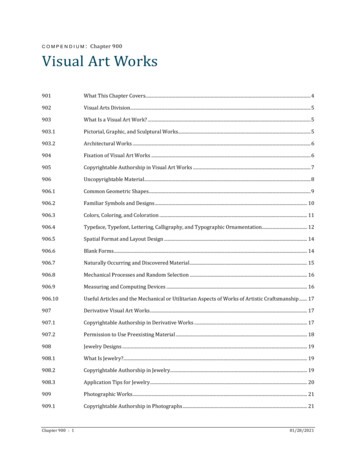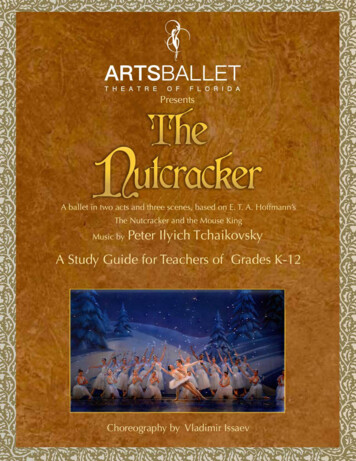
Transcription
V L A D I M I R I S S A E V, A R T I S T I C D I R E C T O RDear educator,Thank you for choosing Arts Ballet Theatre of Florida’s The Nutcracker as your preferredOutreach Educational Program.This guide will provide you with materials and information to prepare you and yourstudents for the upcoming performance you are going to experience.It includes a synopsis of the ballet, information about the composer and the choreographer, other educational information and activities for your students to follow.Please, apply accordingly to their ages and experience and feel free to copy and distributeany materials in this guide for your students or for other teachers as necessary.The performance you and your students are about to see features excerpts of both Act Iand II of the full-length presentation of Vladimir Issaev’s The Nutcracker.Our beautiful scenery, renovated costumes, and gorgeous choreography will provide yourstudents with a very unique experience.The Nutcracker is a story about dancing snowflakes, sugarplums, naughty little boys,magical dolls, and beauty beyond imagination danced to Tchaikovsky’s famous musicalscore.The dancers and staff of Arts Ballet Theatre of Florida, look forward to having you attendour upcoming performance.We hope you enjoy our show!Sincerely,Educational Program CoordinatorArts Ballet Theatre of FloridaT: 305.948.4777E: abtflorida@aol.comVisit us online: www.artsballettheatre.org
For the teachersPreparing Your StudentsBefore attending the ballet, let’s learn some facts about this verybeautiful art.What is Ballet?First positionBallet is a way of telling a story using music and dance instead ofwords. Dancers who perform ballet on stage are highly trained.Ballet is a distinctive form of dance that requires a special technique established almost 500 years ago. It began in the courts ofItaly and soon spread to the French courts. The first realballet, mime, music and dance were combined in one performance.When ballets were first performed, men played the female parts,they wore wigs and masks. Girls didn’t dance at all.All ballet steps have French names, these steps were first introduced by a ballet master in France many years ago.Second positionThere are five positions:First Position: The balls of the feet are turned out completely. Theheels touch each other and the feet face outward, trying to form astraight line.Third positionSecond Position: The balls of both feet are turned out completely,with the heels separated by the length of one foot. Similar to firstposition, but the feet are spread apart.Third Position: One foot is in front of the other with the front foottouching the middle of the back foot.Fourth positionFourth Position: The feet are placed the same as third position,but one step apart.Fifth Position: With both feet touching, the toes of each foot reachthe heel of the other.Fifth position
THE NUTCRACKERBefore attending the ballet: Tell students that The Nutcracker Ballet is an annualholiday event in communities across the country. Askwhether any child has ever seen the ballet performed orwhether they know anyone who has danced in a performance. What other activities do the students do aroundthe holiday season? Read The Nutcracker. Ask if anyone has ever had adream? Can they remember their dream? Listen to selections of The Nutcracker Suite by P.I.Tchaikovsky. Divide children up into small groupsand allow them to create their own dances with thedifferent pieces of music. What do they imagine is going to happen duringthis piece? Have them write a story or draw a picture and compare it to what they actually do see. Discuss with your students what is necessaryto put together a performance of The Nutcracker.Discuss the people involved and what their jobs are tocreate this huge production: Choreographer: This person creates the steps of thedances. Dancer: This person performs the choreography onstage. Stage hand: This person performs a variety of backstagework, including hanging drops, moving sets on and off thestage, monitoring props, etc. Costume Designer: This person designs and assembles thecostumes for the dancers. Lighting Designer: This person designs the lights that will setthe mood of the ballet. Sound Technician: This person sets up and operates the equipment for the music. Stage Manager: This person directs everyone backstage to dohis or her job at the correct time so that the production can runsmoothly. Research and present to the students the life of Tchaikovsky. Have them research different composers of the eraand compare what they find to what they know about Tchaikovsky’s life. For example, were they child prodigies? Did theyhave any other jobs besides being involved in music? Didthey write ballets? etc.
For the teachersIt’s Show Time: Audience EtiquetteGoing to see a dance company or other performance groups in a theatre can be a magical,memorable event for the audience.Make the children understand the importance of a well behaved audience.Whether they are coming to see a play, a musical, a concert, or a ballet, the rules are thesame. The performers are working very hard to please the audience. When you show thatyou are paying attention and are enjoying the show by clapping, smiling, and laughing, ithelps them to do a better job.After entering the lobby of the theatre, students should stay in a single file line. This willmake it easier for your class to walk together down the aisles without getting separated orinterrupting other groups of audience members.After the children are seated, the lights will dim until it is dark in the seating areas, butthere is some light near the stage. This is a sign that the performance is starting. The curtains will open only after the lights have dimmed. The opening of the curtains means thatthe performance has begun.When the performance is over is the appropriate time for applause. Applause is greatlyappreciated by all of those who worked on the production; however, please remember thatyelling is never appropriate behaviour for the theatre. Read these rules to the students:
TO DO RULESNOT TO DO RULESDo make sure you are ready to sit and enjoythe show with plenty of time before it starts:get a drink of water if you are thirsty, visitthe bathroom, get a Kleenex if you need one.Do make yourself comfortable in your seat.Do clap if you want to show the dancers youliked what you saw. Dressing nicely as asign of respect to the artists and the theatre.Do tell a teacher, parent, or chaperone before the show if the person in front of you isso tall that you may not be able to see well.Sometimes it helps to change places to makesure everybody can see.Do not talk, laugh or whisper with companions. Excessive noise making is verydistracting and disrespectful to the performers.Do not eat during the performance: Theatres do not allow food in the seating areas.In the lobby refreshments are often servedduring intermission, before and after theperformance and are to be consumed in thelobby.Do not take pictures or video tape. Photographs and/or audio and video taping arenot allowed in the theatre not only becausethey are distracting to the performers, butalso because it is considered an infringement on the copyright lawDo not leave your seat once the showstarts. The theatre will be dark, and peopleshould leave their seats only if they havea very important need . Do not stand up,because people behind you won’t be able tosee.
A ballet in two acts and three scenes, based on E. T. A. Hoffmann’sThe Nutcracker and the Mouse KingFOR BOTH, TEACHERS AND STUDENTSAs the holiday season approaches, many dancers, professionalsand non professionals around the world, from the smallest to thebiggest ballet company, begin rehearsals for the most popularholiday entertainment traditions: The Nutcracker.The Nutcracker has every element of a classic fairy tale, from themagic and mystery of dancing dolls, snowflakes and candy sweets,to the battle of the toy soldiers and the mice, and thefantastic journey of the young Clara and herNutcracker Prince.The Nutcracker was first performed at theMariinsky Theatre in St. Petersburg, Russia on December 17, 1892. Thegreat choreographer, Marius Petipacommissioned composer Peter IlichTchaikovsky to compose the score forthe ballet. Petipa drafted the librettobased on Alexandre Dumas’ adaptation of the tale of The Nutcracker and the Mouse King by E. T.A. Hoffmann. Soon after sending the musical specifications for theballet to Tchaikovsky, Petipa fell ill and his assistant, Lev Ivanov,completed the choreography. When the ballet premiered, no onethought it could be a success. However, the choreography for theSnow Scene and the Grand Pas de Deux of the Sugar Plum Fairyand her Cavalier was considered magnificent.In 1934, The Royal Ballet in London, staged Ivanov’s choreographyunder the title Casse-Noisette (Nutcracker in French). In 1944, thefirst production of The Nutcracker in the United States was stagedby San Francisco Ballet. Through the years, ballet companiesworldwide have adopted The Nutcracker as a permanent feature in their repertory.The beauty of Tchaikovsky’s score and the charm of the story for holiday entertainment haveinspired many choreographers to stage their own versions of the ballet.In 1997, Arts Ballet Theatre of Florida, staged for the first time some suites or dances ofVladimir Issaev’s version of The Nutcracker, and it was not until 1999 when a full production was presented with scenery, special effects and gorgeous costumes by our company.
For the childrenWho is who in The Nutcracker ?THE MUSIC MAKERPeter Ilyich Tchaikovsky.THE STORY MAKERE. T. A. Hoffmann.Ernst Theodor AmadeusHoffmann (January 24,1776 - June 25, 1822),was a German romanticand fantasy author andcomposer. He changedhis third name fromWilhelm to Amadeus in1813 in homage to the renowned composer Wolfgang Amadeus Mozart.Hoffmann’s stories weretremendously influential in the 19th century,and he is one of the keyauthors of the RomanticMovement.Tchaikovsky was born in Kamsko-Votkinsk, Russia. Musically precocious, he began pianolessons at the age of five. Hewent on to study at the St.Petersburg Conservatory from1861 to 1865. In 1866, he wasappointed professor of theoryand harmony at the MoscowConservatory, established thatyear. Tchaikovsky traveled constantly, not staying long in anyone place. He began conductingorchestras after filling in at aperformance in Moscow of hisopera, The Enchantress. Tchaikovsky visited America in 1891in a triumphant tour to conductperformances of his works andin 1893, was awarded an honorary Doctor of Music degreefrom Cambridge University.Tchaikovsky died on November6, 1893.THE BALLET MAKERVladimir Issaev.The Choreographer VladimirIssaev was born in Russia in1954. His career started atthe age of 11 at the Choreographic School of Voronezh.After working as a balletdancer at the Opera Houseof Odessa, he studied at the“Gitis Institute of Arts inMoscow” where he graduatedas Ballet Master and MasterChoreographer in 1986. He iscurrently Ballet Master, Choreographer & Artistic Directorof his own school VladimirIssaev School of ClassicalBallet and of the professionalcompany Arts Ballet Theatreof Florida.As a Choreographer, he hascreated several ballets in Russia, Japan, Indonesia, SouthAfrica, the United States,Puerto Rico, Mexico, Peruand Venezuela. Among manyother accolades, in May of2009 Mr. Issaev was awardedMost influential teacher bythe National Advancement forthe Arts of the US and BestEducator in the Arts by theFlorida Alliance of Arts Educators and he received the2015 Miami Life Award.
SynopsisFor the ChildrenFirst ActIt is Christmas Eve at the Stahlbaumhome. Family and friends gather aroundthe beautifully decorated tree; it’s a night ofrejoicing, exchanging gifts, and dancing. Thejoy is suddenly interrupted when Herr Drosselmeyer enters. He is a strange, but kindold man who brings beautiful life-sizetoys for Clara and Fritz, which danceat the touch of his wand. Drosselmeyerhas another present for Clara: a Nutcracker. When the party is over and allthe guests leave, Clara sneaks downto the living room in her nightgown totake another look at the Nutcracker.The clock strikes midnightand as Clara goes to fetchthe Nutcracker, pandemonium breaks loose;toy soldiers come to lifealong with the mice.A great battle takesplace as Clara huddles in her chair. TheMouse King fightswith the Nutcracker. Clara saves theNutcracker by hittingthe Mouse King’shead with her shoe.The battle is over and Clara is now transported to the Kingdom of Snow where shemeets the Nutcracker, transformed into aprince.Second ActAfter dancing with the King andQueen of Snow and the Snowflakes,Clara and her Prince are taken to theKingdom of Sweets where they aremet by the Dew Drop Fairy and herCavalier. The celebration begins intheir honor, and dances representingChocolate from Spain, Tea from China, Coffee from Arabia, and Marzipan follow. Flowers delightthem with a waltz. Totop it all, the Sugarplum Fairy and herCavalier honor Claraand her Prince witha beautiful Pas-deDeux. Everyone joinsin the dancing of aspectacular Coda.
After the BalletFor the Teachers-Apply accordingly to the age and level of the studentsAssign the class to write a newspaper or magazine review of the performance. Discuss elements of a good review. What did you like about the ballet? and why?Ask them how many dancers were there performing at one time? how were they interactingwith each other? Were they moving in unison?Different dancers in the ballet played different characters. How do the dancers’ movementslet them know which character they were playing?You can ask them: When was the last time you lifted a person above your head and have itappear effortless? Or performed several gravity-defying leaps?Make emphasis on the fact that Ballet can be enjoyed by boys, girls, men and women. It isvery hard work and requires great athletic ability, coordination and strength. Many dancersperform a 2 ½ hour ballet with only a few short breaks. Male ballet dancers have to jumphigher and turn more times than their female counterparts.Ask students to describe the motions of the dancers in the performance that they saw andwhat they thought those motions symbolized. Have students brainstorm movements fromdances that they are more familiar with (break-dancing, hip-hop, jazz, etc.) and what theysymbolize. Have students compare and contrast the styles.Another idea is to have them write thank-you notes to the dancers (DANCERS LOVE TOHEAR FROM YOU!).Discuss with students how the performance was different from what they expected. Whatparts did they like/dislike? Would they want to go to a ballet performance in the future?What did they learn? You may want to quiz them verbally on some aspects of the performance.Have students draw, paint or color a scene that they liked best.Discuss the similarities and differences of the ballet performance and theatre to other performances students may have been to such as a movie, a sports event, a rock concert, or aschool play. What are the differences between a live performance and one on television orvideo?
Post-Performance Activities / Language Arts / Grades K-1NAMEGRADEWhat scene did you like most about The Nutcracker ballet.Draw a picture of that scene
Post-Performance Activities / Language Arts / Grades 2-3NAME GRADEWrite a friendly letter to one of the characters or dancers from TheNutcracker.Describe what you liked best about the character you chose.
Social Studies & Language ArtsChange the Setting for The Nutcracker / Grades K-12The Nutcracker is a ballet set in Western Europe in the 1800s.What would happen if the story took place in 2017 and in Florida?Re-write your own version of the story using a different setting, timeperiod, or both, be sure that they consider how costumes, sets, characters, folk dances, music, landmarks, locations, events, and animalsmight be different.
Draw a picture that illustrates your new version of The Nutcracker
Photography / Patricia LaineDesign / Godofredo Romero pinineco2002@gmail.com The Nutcracker Ballet / Word COMPOSERCORPS DE BALLETDROSSELMEYERGENREHOFFMANMOTIFMOUSE KINGNUTCRACKERPANTOMIMEPAS DE DEUXPOINTE SHOESREHEARSESET DESIGNERSNOWSUGAR PLUM FAIRYTCHAIKOVSKYTEMPOTUTU
Before attending the ballet, let’s learn some facts about this very beautiful art. What is Ballet? Ballet is a way of telling a story using music and dance instead of words. Dancers who perform ballet on stage are highly trained. Ballet is a distinctive form of dance that requir
